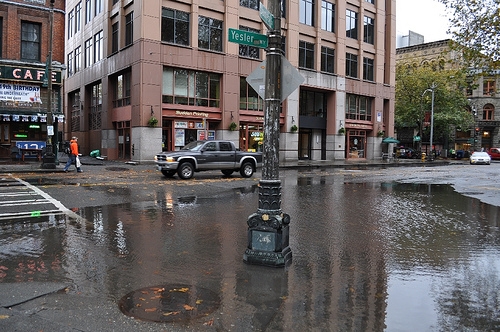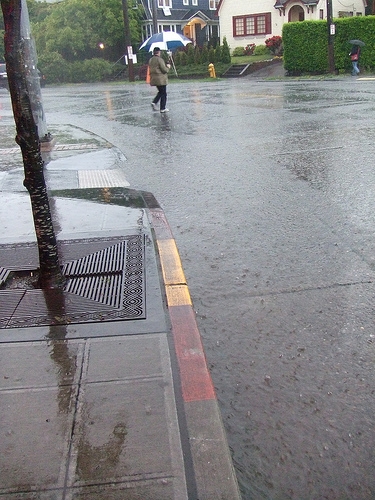
Image of flooding at Yesler Street in Seattle by Peter Mooney
Yesterday I read an excellent article on Sightline Daily summarizing and analyzing the Washington State Department of Ecology’s latest “draft draft draft” LID Stormwater Standards. This plan outlines WA DOE’s strategy for integrating Low Impact Development (LID) solutions to reduce polluted stormwater runoff that has long threatened nearby waterways, Puget Sound being one of the most notorious.
It’s a long, detailed post — so get our your reading glasses and be prepared to spend a little chunk of time reading through it. It is well worth the time.
According to Sightline, “The grossly over-simplified, five-second summary of what’s being proposed: rain gardens and porous pavement are in, green roofs are in for commercial projects, water harvesting and reuse is out, and preservation of trees and other native plants — the most sure-fire way to control toxic stormwater runoff — is encouraged, but not strongly enough given its importance.”
Uh, OK, this gets us a little nervous.
Puget Sound Partnership, EPA, and NOAA Fisheries Service are all nervous too, and have submitted comments requesting that the Department of Ecology strengthen the requirements to control runoff and tighten the timeline (currently set at the end of 2014 and 2015) for compliance significantly.
It seems that the report has missed the point on the significance of green infrastructure as well as its very real ecological AND financial value. A few of the most egregious misses include:
– Allowing “highly urbanized” sites to model the allowable runoff based on existing hydrology rather than pre-development hydrology
– Stating that commercial buildings must include a green roof or a conventional roof whose runoff can be chaneled underground but then allowing that exemptions can be made on the basis of cost
– Not emphasizing of the role that native trees and vegetation play in a successful and ecologically sound stormwater management plan
No doubt there is more to pick apart, but I’ll leave that to the experts.
Sightline’s article goes on to say, “Commenters on the draft plan worry that the model de-emphasizes the conservation of trees and plants in trade for engineering “tricks,” when trees and vegetation may in fact be the single most effective solution. Taken to an extreme, the approach could result in a treeless development paved in porous concrete — and still meet the rules if the stormwater volumes met the calculated goal.”
Now that is an outcome that would be a huge disservice to the green infrastructure movement.

Image of flooded Seattle street from bitmask





Leave Your Comment